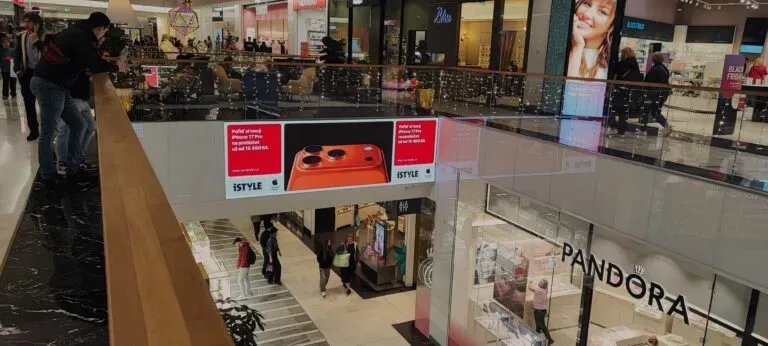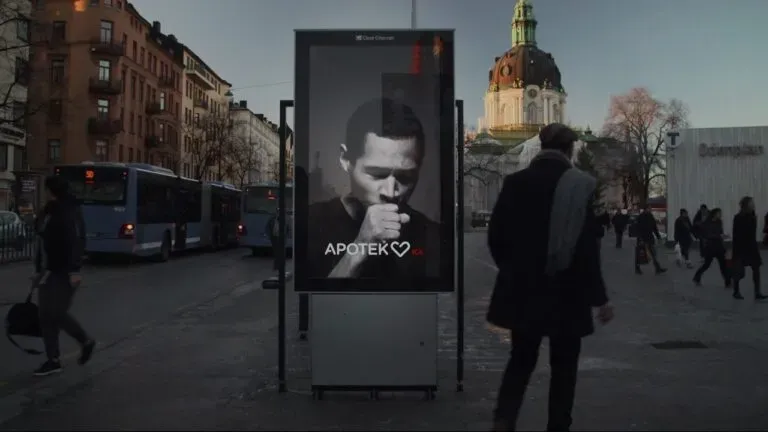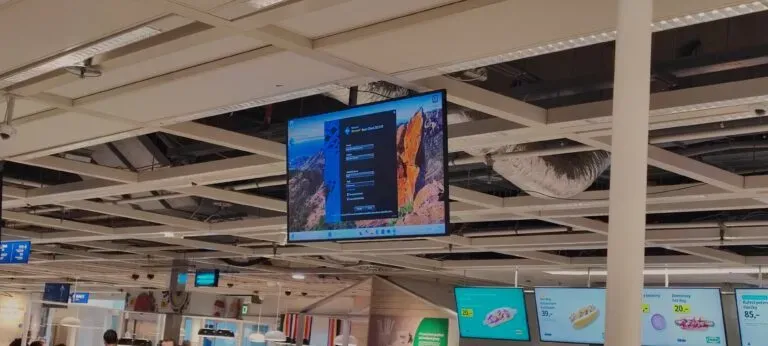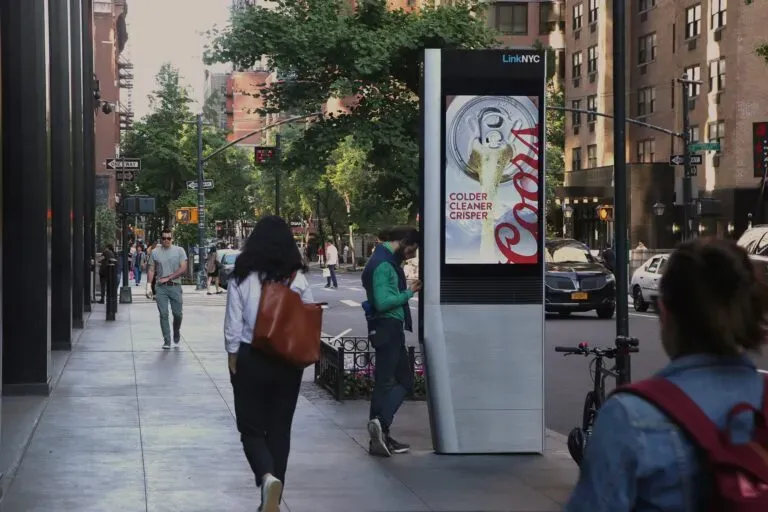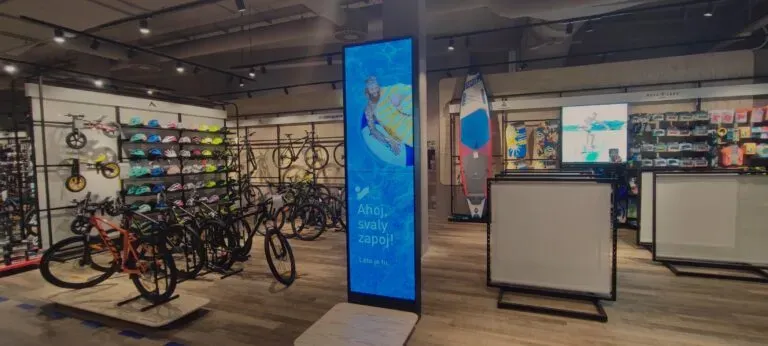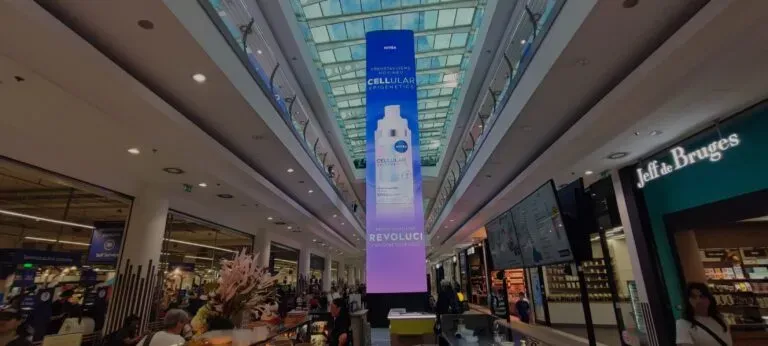Digital Signage: 6 cases of successful digital screen implementations in retail
Digital Signage have long become an important component of modern trade.
Many companies are switching to digital signage solutions to enhance the effectiveness of communication with customers and attract their attention to key products. Thanks to dynamic visual materials that are easy to update, stores can quickly respond to changes in demand, seasonal trends, and new marketing campaigns.
More and more retail chains are using screen software to improve the quality of the customer experience. Modern digital technologies make it possible to optimize product presentation, display promotional offers, and manage a large number of displays simultaneously. In turn, digital advertising on such screens makes offers more attractive and contributes to a more accurate influence on buyer behavior.
For retail, it is especially important to create a space where visitors can quickly find the products they need and easily navigate the large selection. That is why digital signage in retail has become a tool that combines marketing, navigation, and assortment presentation into a single interactive mechanism. Properly implemented screens not only improve the visual design of the store but also create a deeper emotional connection with the brand.
Below, we will look at real examples of how digital signage solutions have allowed large companies to increase sales efficiency and strengthen their positions in the market.
Case №1: Home appliance store
A large electronics store installed interactive touch panels that allowed customers to compare the specifications of smartphones and laptops directly while choosing a product. Thanks to a convenient menu, clients could watch video reviews, read user feedback, and ask the virtual assistant questions, receiving instant answers.
The approach proved extremely effective. The average receipt grew by 15%, and the number of purchases increased by 10%, as access to detailed information helped people make decisions faster. Buyers noted that they liked being able to study the equipment independently without feeling pressure from salespeople, while the accurate and structured information on the screens simplified the entire selection process.
Overall, the interactive panels significantly improved navigation through the assortment, made the store more technologically advanced, and contributed to greater customer trust in the brand. This is a telling example of how modern digital tools can strengthen competitiveness even in a highly saturated electronics market.
Case №2: Healthy food supermarket
A well-known retail chain decided to update the concept of its main supermarket by adding a modern digital menu to the sales floor, which became an important part of a new approach to interacting with customers. On large screens, visitors were offered recipes for healthy dishes, recommendations on combining ingredients, and tips on how to choose the freshest vegetables and fruit. This focus on education and inspiration formed a completely different style of service—warmer, more attentive, and useful.
A special role in this solution was played by a modern player for digital signage, which made it possible to broadcast high-quality content stably and without failures. Thanks to reliable software, the supermarket could dynamically change the menu, add new recipes, and quickly respond to the seasonality of goods. Customers began to spend more time by the screens, which had a positive effect on the average ticket.
Already three months after the implementation of the updated digital signage system, the supermarket’s revenue increased by 12%. Regular customers started returning more often, as they felt that the store offered not just products, but additional value—useful tips, knowledge, and inspiration for cooking healthy meals at home. This approach significantly increased trust in the brand and strengthened the sense of attention to each customer’s needs.
The electronic menu boards also helped to popularize the culture of healthy eating, as bright visual materials easily attracted attention and encouraged visitors to try new products or unusual recipes. The implementation of such a digital system became an important step for the retail chain, which sought to make the shopping process not only convenient but also educational.
Case №3: Fashion store
A clothing brand decided to update its approach to presenting collections by integrating interactive displays for customers into the sales area. They broadcasted style tips, outfit combinations, seasonal offers, and promotional campaigns. Thanks to this solution, the store created the atmosphere of a fashionable showroom, where buyers could get inspiration and ideas for creating their own style.
The screens regularly featured presentations of past season collections, which were sold with discounts, as well as announcements of new contests and raffles for visitors. The interactive format meant that people engaged more actively with the content: they participated in promotions, scanned QR codes, learned about new arrivals, or chose accessories that best matched their selected clothes.
The use of a compact Android set-top box proved especially effective, as it provided stable playback of promotional materials and allowed for quick content updates without complicated technical procedures. This greatly simplified the staff’s work and increased the flexibility of marketing campaigns.
Just six months after the launch of the digital promo screens, the profitability of the retail location increased by 18%. The brand became more talked about, as its promotions grew more noticeable and its product presentations became more dynamic and attractive. Customers appreciated the store’s interactivity and technological features, which increased overall loyalty and customer activity.
The use of modern digital solutions allowed the brand not only to stand out among competitors, but also to create a new quality of interaction with customers—more lively, emotional, and personalized.
Case №4: Retail hypermarket for building materials
One of the largest sellers of building materials decided to completely modernize its visual communication in the sales floor. Instead of traditional paper posters, the company implemented advertising screens, which made it possible to significantly improve the delivery of information and made promotional offers more noticeable. Moving banners and animated special offers attracted the attention of visitors from the very first days after launch.
During the transition to the new concept, a reliable centralized video management system played an important role, thanks to which staff gained the ability to instantly update advertising blocks, change priorities of promotions, or integrate urgent announcements directly from the service terminal. This ensured flexibility of work and minimized the risk of errors, which often occurred when printing and physically placing updated materials.
To play content in each zone of the hypermarket, an Android media player was used, which made it possible to achieve stable operation and smooth display of graphic files and video. The devices were easily synchronized with the central platform, which meant all advertising messages were updated simultaneously, without delays or technical problems. This enabled the store to maintain a unified style and relevance of all information in the store.
Content management was carried out through a convenient CMS (Content Management System), which allowed the marketing team to quickly create new banners, analyze the effectiveness of promotions, and control the scheduling of displays on various screens. Marketers got more freedom—they could now test different video formats, compare customer reactions, and adapt messages for certain categories of goods.
The implementation of digital technologies delivered tangible results. Promotional income increased by 15%, since customers more often paid attention to offers that changed constantly and looked much more dynamic than ordinary posters. Meanwhile, the costs of printing advertising materials were halved, which became an important factor for long-term savings.
This case proved that digital signage in retail can significantly increase the effectiveness of advertising campaigns and help the company stand out among competitors. The hypermarket started to look more modern and technologically advanced, and customers gained access to up-to-date information in an interactive format.
Case №5: Chain of cosmetics stores
A well-known chain of decorative and care cosmetics stores decided to update the approach to product presentation, focusing on improving interaction with customers in the sales area. The company installed multimedia displays next to themed stands so that customers could watch makeup artists’ tips, instructions for using products, and reviews of trending items. This format helped turn familiarization with the assortment into an engaging process.
Customers began to explore new products more actively, since each video explained in detail the features of applying cosmetics and demonstrated real results. The store got an additional advantage—the ability to present seasonal collections and partner brand campaigns without delays, immediately after their launch.
Another important effect was the increased engagement of the younger audience, which responded positively to video content and dynamic formats. In the first four months, sales of decorative cosmetics grew by 11%, and demand for new categories of goods by 8%. The retail chain confirmed: modern digital presentation of content enhances customers’ emotional connection with the brand and stimulates interest in products.
Case №6: Home furniture and decor store
A home goods store decided to modernize the way it presents furniture and decorative solutions. Large video panels were installed in the sales area, displaying ready-made interior compositions, combinations of colors, lighting options, and examples of furnishing apartments of different sizes. Customers gained the opportunity to immediately see how the furniture would look in real conditions.
Digital demonstrations helped better communicate the benefits of complex products, such as modular storage systems or convertible sofas. The videos clearly showed the installation process, various configurations, and usage scenarios. This significantly simplified consultations and reduced the burden on sales staff.
Additionally, a zone with digital catalogs was created where customers could browse large collections not physically displayed in the store. This approach expanded sales opportunities, as clients were able to access the entire assortment without needing to visit a warehouse or wait for a printed catalog.
Six months after the integration of multimedia solutions, sales of premium-segment furniture increased by 17%, and the number of repeat visits—by 9%. Customers noted that the store managed to make shopping more informative, pleasant, and inspiring.
How to implement digital screens in a retail company?
To successfully integrate modern technologies into a retail business, it is important for retailers to carefully think through every stage of implementation. Digital screens help enhance communication, make the store more dynamic, and create a better experience for customers. At the same time, for maximum return, several key details should be taken into account.
First of all, it is worth identifying areas with the highest concentration of clients. It is precisely there that advertising screens will work most effectively, as customers will be able to notice important messages, promotions, and recommendations. In sales areas, such zones usually include checkout lines, entry groups, departments with popular goods, and stands with new products.
It is important to regularly update the content so that it remains relevant and lively. Using a convenient CMS (Content Management System), marketers can quickly change videos, test different formats, and adapt messages to the season or audience behavior. This helps avoid monotony and maintain customer interest.
No less important is the combination of digital formats with traditional marketing tools. The digital menu, printed navigation, product stands, and demonstration zones should work as a single ecosystem. This amplifies the effect of advertising and creates integrated brand communication.
To play dynamic content, it is advisable to use an Android media player, which ensures stable operation and easy integration with other store systems. Such a solution helps avoid technical failures and guarantees smooth playback of videos and animations on different panels.
In large chains, the centralized video management system plays a special role. It allows for controlling dozens or even hundreds of screens simultaneously, updating advertising blocks, and monitoring the effectiveness of each campaign. Thanks to this approach, marketing teams can work faster and more accurately, responding to market changes almost instantly.
It is also important to take into account the format and placement of equipment. If a store actively uses digital signage in retail, it is better to adapt content to specific zones—electronics department, food shelves, fashion sector, or self-service counters. In each area, the content will have its own role, from informing to creating impulse demand.
Stores that focus on innovation should also consider the possibility of integrating interactive displays for customers. Such panels help visitors browse catalogs independently, study product characteristics, and receive personalized recommendations.
Another important element of the ecosystem is the player for digital signage. It ensures the stability of the entire system and prevents delays in content playback. In combination with an Android set-top box, this makes the digital network as flexible as possible.
For businesses looking to expand, the best solution is a comprehensive digital signage system that combines all technologies into a single process. It enables scaling the screen network, launching new locations, and standardizing visual communication.
If a company plans to launch digital signage in retail, it is also important to consider the quality of software. Reliable software for screens allows for remote, real-time management of content, as well as seeing effectiveness statistics and adjusting advertising strategies.
Digital signage solutions enable businesses to respond to demand faster, strengthen emotional connection with customers, and make stores more modern and technologically advanced. The right implementation strategy transforms digital screens into a growth tool, not just a decorative element.
If you plan to implement digital signage in your business, take care to choose a flexible platform, modern equipment, and a clear content strategy. It is precisely the combination of these elements that will ensure stable results and increase the effectiveness of your advertising communication.
Advision is a content management system for remote control, media planning of video and audio content broadcasting, and a supply-side platform for monetising advertising time. We also implement a Wi-Fi tracking system to measure quantitative indicators of the advertising audience. We help Digital Signage owners and DOOH advertising operators earn money from advertising, automate work processes, and build a reliable media infrastructure using AdTech and MarTech software solutions.
Contact us if you want to increase your profits and implement the latest technologies to solve your problems!
Share the news


